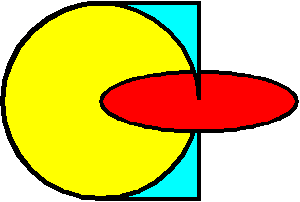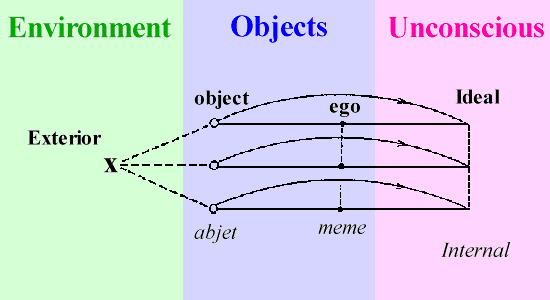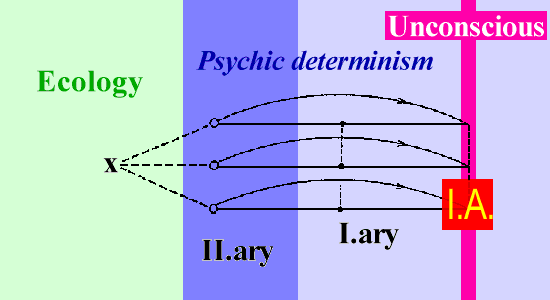
 QUICK, an answer
QUICK, an answer

 |
|
|
|
Daniel is an opponent to psychoanalysis (re Doc
below). Richard intends to extend psychoanalysis towards collective psychology;
he writes his conceptualization of how one might begin to accomplish this (re Doc below). |
We can start with Freud's graph, that he established when he
first tackled the relationship between ego-analysis and collective psychology.
Here is the graph (pic.01) that Freud draw in black, and with colors my reading: green
is the exterior, blue the culture
inasmuch our mind and body represent its object, and pink
the Unconscious inasmuch it represents the psychic function of specific
elements of society.
There are two notions that my conceptualization operates:
1) The green and the pink
are twice connected together: that are obviously connected by the blue
in between them, but also they directly rejoin like East and West as the Right
and Left on a map. Actually it is not because the world in round in this case,
but because the Freudian universe is like a moebius coil - following Lacan's
topology (see Schema R the blue
stripe represents a moebius coil - hence the right and left extremities are
reversed, opposed and the same).
2) I make a distinction between the immobile
blue objects (a
series a coded elements) and the mobile
blue objects: the mobile as the primary processes and/or objects for
primary repression, the immobile as the secondary processes and/or objects for
secondary repression (the former has been theorized by Verdiglione - as Semblant
or meme - the latter by Sartre and Laing).
With this graph I can understand Richard when he writes: ...some idea entering into the mind from the external world has been internalized to the extent that it controls the mind and body.
From this point of view, from the internal
to the external, the graph represents
the externalization in a way that
is culture, in the sense Richard writes: Culture is the externalization of
our deepest unconscious fears and desires.
This may be even clearer with colors - Culture
is the externalization of our deepest unconscious
fears and desires - where the direct/Moebian link between fears, desires, and
unconscious is expressed, in a way that their separation also makes sense.
In order to find this sense in our experience, I have
answered this question as to speak of "hegemony" is simultaneously
to speak of "attachment", in identifying these fears and
desires as the environment -
thus making the Freudian conceptualization an ecology (pic.02).
It has requested a focus on the said unconscious as this
internalization through forms, structures, as the ideology
or institution that Richard mentions (as coming into being - that
is Ego Ideal) especially when it lays a special product that is
cybernetics. This product that is Artificial
Intelligence (
I.A.)is now indicated as red
in the second schema (as it was already indicated in older
illustrations that I have published).
By consequences, on the basis of this conceptualization, I read that Richard intends to psycho-analyze society in term of uncovering the psychic function that lay in the cultural span. I pretend that something quite different has to be done inasmuch I represent the object of my psychoanalysis as nature - and this is how psychoanalysis comes to term with science. If I may further use colors, I may say that, in identifying psychoanalysis as ecology, I consider the whole natural span.
This happens to produce a kind of gay flag - why not; except if it lays way to an insult, censor, fag. It is even useful in addressing the question Daniel raises regarding education and repression in childhood.
In my opinion, Daniel is someone who knows psychoanalysis through its official representatives - being bold I would say during a time of Renaissance, who knows Jesus through the Inquisitors. However, he has to admit that psychoanalysis is a theory that acknowledges a phenomenon of resistance as part of the human development and thus, part of its own. Moreover, its own development helps understanding ours:
In Daniel question, feces and penis are two objects children
are content to play with. Insofar the penis is surplus-valued by ulterior sexual
and reproductive relationship, we can compare the former with a primary object
and the latter with a secondary object for repression. Parents who would treat
them equally would operate a repression as limiting psychoanalysis to a cultural
span is a resistance in the development of psychoanalysis towards ecology. The
child in this case would not be able to use the cultural
command as a way both to mediate its social/sexual
relationship and environmental/reproductive
constrain. This child would see a super-ego - as Daniel says: an immense
ego - which would represent a self-meaning society.
Different would be a child whose parent makes sense with primal
defenses which protects the child's life (one can be sure he will be grateful)
and secondary set of laws (that will spare him ever being hateful).
DOCUMENTS
1) DANIEL
The question from the scientific archaeological/Egyptological group
|
William Theaux wrote: > (snip) Egyptologists realize that they go as far a digging and putting It takes immense ego to play only with the penis. Children, however, are content to play with both if you let them, but they are denied both by their parents. What about that as repression? Daniel |
2) RICHARD
The question of the thread was: psychoanalysis and science - "Why
would one experience theorizing as "dangerous?"
|
Richard A Koenigsberg Objet : Real psychoanalysis ? De : Psychoanalysis [mailto:PSYCHOAN@MAELSTROM.STJOHNS.EDU]De la part de Envoyé : dimanche 7 janvier 2001 21:50 À : PSYCHOAN@MAELSTROM.STJOHNS.EDU Message text written by Psychoanalysis >E=3Dmc2 has been dangerous insofar psychoanalysts failed with their service to collective psychology< I agree. Psychoanalysis must turn to the study of the shared psychological processes that give rise to social institutions, and the manner in which unconscious fantasy is played out on the stage of reality. Below is my conceptualization of how one might begin to accomplish this. To psychoanalyze society is to identify the unconscious sources of its cultural formations. For any ideology or institution we may pose the question: "Why does it exist?" To understand an element of culture one seeks to uncover the psychic function it provides or performs. An ideology or institution comes into being and is embraced and perpetuated insofar as it does something (psychologically) for individuals within that society. Culture is a social construction. However, it also performs a psychic function. Questions posed by a psychoanalytic approach to the study of culture revolve around the source of, or motivation underlying, the creation and perpetuation of specific cultural forms. For each structure within a society we pose the question: What is its meaning, the psychological work it performs for members of that society? Our analysis begins with the human being. The fundamental resistance governing social and historical inquiry is the fantasy of the existence of an independent world "out there" separate from the human mind. When we speak of "hegemony," what does this mean? That some idea entering into the mind from the external world has been internalized to the extent that it controls the mind and body. Howard Stein has posed the question: "Why can't we walk away from it?" What he is suggesting is that culture oppresses only to the extent that we cannot abandon it. Thus, to speak of "hegemony" is simultaneously to speak of attachment. The "dream" of culture (Stein) is the fantasy of forces outside the self that are other than a human creation. We experience "society" as if it is hovering above us and cannot be resisted. The psychological question is: why are hu-manly constructed entities invested with such power. Freud's idea of "psychic determinism" permits one to analyze dreams, slips of the tongue, and psychosomatic symptoms by virtue of the assumption that there are no accidents in the life of the mind. Our unconscious mental life is the source of the images we dream at night, the mistakes and blunders of our everyday life, and the pains in our bodies. To psychoanalyze culture, we extend the principle of psychic determinism. This is the crucial step that permits us to interpret the structures of society. We assume that cultural formations do not arise and historical events do not happen by chance. There is a psychological source underlying everything that occurs in society. Culture is the externalization of our deepest unconscious fears and desires, providing the framework for expressing, articulating, and coming to terms with these fears and desires. To psycho-analyze culture is to seek to uncover, lay bear the meaning and psychic function of specific elements of society. R. K. |
© CYBEK 2000